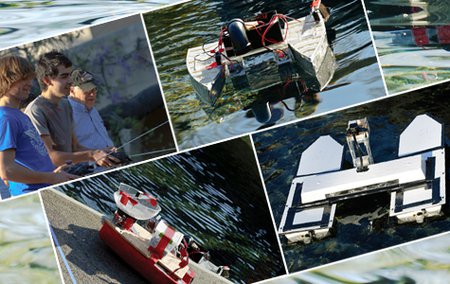Robots designed and built by Caltech undergraduate students will battle in head-to-head competition on Thursday, March 8, in what has been dubbed "The Conquest of Millikan Islands," this year's ME 72 Engineering Design Contest. Setup for the contest, which has become a popular event in the Division of Engineering and Applied Science, begins at 1 p.m. at Millikan Pond, and the competition is scheduled to begin around 2 p.m.
"You don't get a whole lot of opportunities like this where you're given a challenge, given a budget, and just told to go do it," says Wesley Swank, a junior mechanical engineering major who is participating in the competition. "If you're a real MechE, you live for that."
In each heat of the double-elimination tournament, two teams will have five minutes to direct their robots to retrieve 11 ping-pong balls from dispensers on the footbridge and to use a second robot to enter the water and deposit the balls on "islands" in Millikan Pond. At the end of each heat, teams will receive points for having their ping-pong balls on the various islands, earning two points for "controlling" harder-to-access islands and just one for those closer to the pond's perimeter.
In this, the competition's 27th year, organizers have added an autonomous component into the mix. To pick up extra points, robotic vessels will be able to head under the footbridge, into an "autonomous zone." Once a vessel enters that zone, its operators must take their hands off the controls, allowing the robot to direct itself. An infrared beacon on an island there will help the robots, outfitted with their own infrared sensors, find their bearings. Getting close to the island will earn a team four points, and depositing a ball on the island will garner a whopping 10 points.
Each team was given $400 worth of radio-control equipment and a budget of $800 for discretionary spending. Some teams are focusing on defense, trying to swat away balls deposited by opponents, while others are more interested in racking up high scores. To convert their designs into actual robots, the students worked in the Jim Hall Design and Prototyping Lab using drills, lathes, a water jet, a laser cutter, and a rapid 3D prototyper. The task also requires some understanding of electronics and computer programming.
"One of the things that's great about this contest is it gives students a chance to build something and see all the complications of it," says John Van Deusen, the mechanical engineering shop supervisor. It's easy enough to draw something up and do all the modeling and everything, but in reality, it's a different world. Just the progression to get these things up and moving is huge."
Juniors Matthew Fu and Christine Viveiros would agree. They have spent about 40 hours each week for a few weeks working on their robots as part of a team called Dim Sum 41. "It's weirdly cathartic while simultaneously masochistic," says Fu. "You spend five weeks tearing your hair out, but when it finally works, you feel really, really happy."
Written by Kimm Fesenmaier





